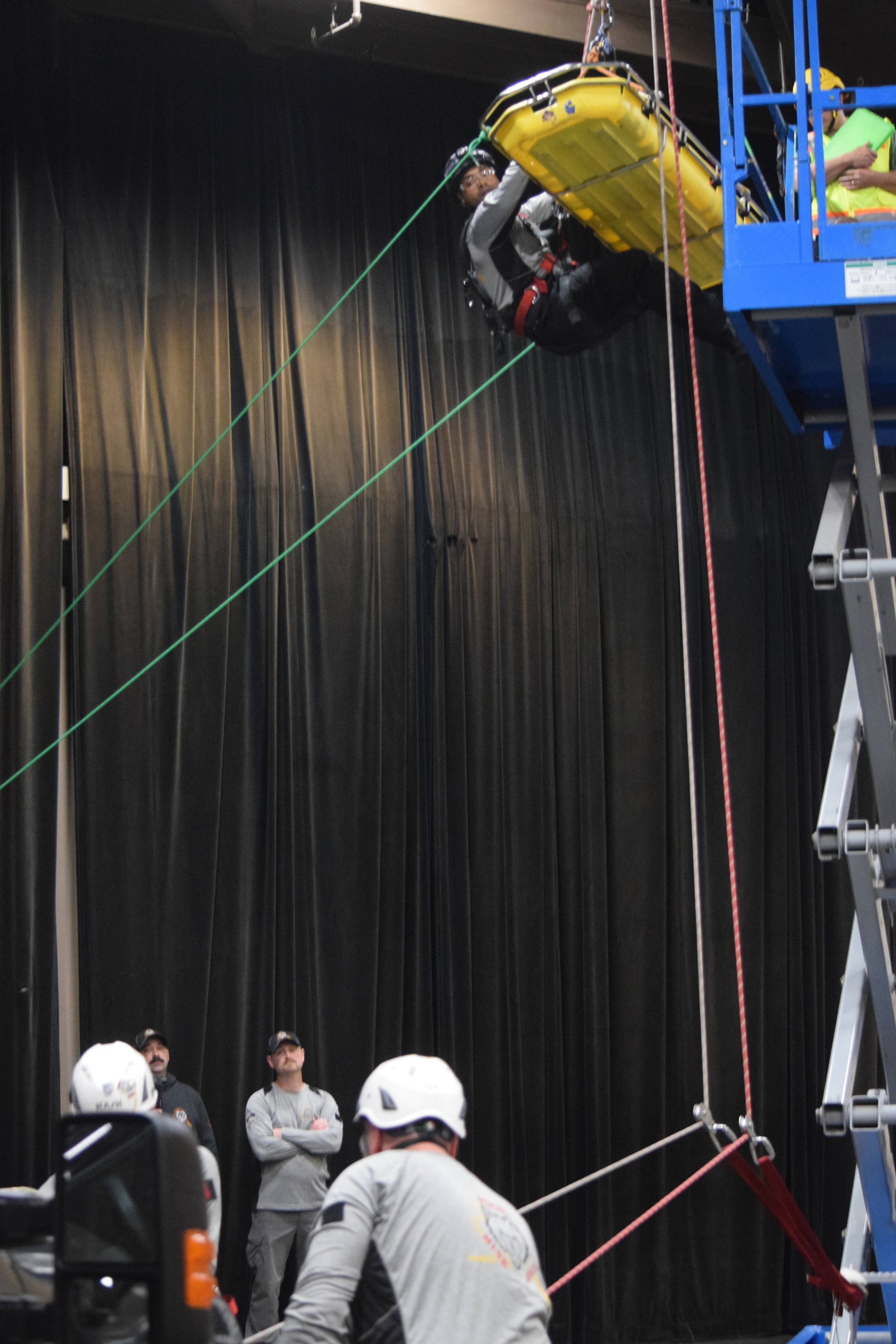Prabin Rashali, of Pogo Mine Rescue, floated in the air about 15 feet over the craned necks of his five team members, who hoisted Rashali with a rope and pulley system to the top of a scissor lift.
Sprawled out on of the lift was a miner, stranded after an electrical failure shut the lift down. Rashali placed the miner in a stretcher, secured him with straps, and alerted his team that he was ready to descend.
“Securing the basket now,” Rashali yelled to his team, who carefully lowered him and the stranded miner to the ground.
A crowd of about 40 clapped when Rashali touched down on Centennial Hall’s polished ballroom floor. The Pogo Mine Rescue Team had completed the rope rescue event at the Central Mine Rescue Competition, an annual event taking place this week which pits seven mine rescue teams from Alaska, Washington, Idaho and British Columbia against one another in rescue skills competitions.
Many rural mines don’t have immediate access to trained emergency personnel and the unique demands of mine rescue mean those responders might not be best equipped to address a mine emergency.
So, many mines develop their own rescue teams, like Pogo Mine Rescue, whose job it is to understand how best to navigate the dark, cramped subterrain in the event of a fire, injury, gas leak or structural emergency.
The rope rescue event wasn’t exactly what the Pogo team would encounter in a real-life mine rescue, but it’s close. A Ford F-250 and the rafters of ballroom served as anchor points for the team’s pulley system. The ballroom floor took the place of the earthen ground inside a mine. The convention centers clear lighting illuminated what might normally only be lighted by headlamp.
In a typical rope rescue, the teams would have to improvise anchor points — and, well, everything else, said Pogo team captain Logan Kennard. To simulate a real life rescue, the team had to assess what rope and pulley system would allow them to lower the miner and Rashali to safety without putting their team members at risk. That means keeping the weight load for each team member under 50 pounds.
“The name of the game for us, we had an initial weight load, and we have to figure out what system is best for that weight load without putting our team in danger,” Kennard said.
Two observers scored the Pogo team on rescue safety and protocol. Kennard said his young team made strides over last year: he expects a better score this year than last year, though they won’t see until Thursday evening.
Miners often volunteer to join these teams. The Pogo team members weren’t assigned, but applied. It’s an extra duty added to their other duties. It gives them piece of mind to know the people and protocols used in the event of an emergency, several Pogo team members said. It’s also a skill they can “take home with them,” team member Sam Pelland said.
The ropes event was one of four teams competed in this weekend. A first aid competition, a technical event and a field competition all took place during the course of the week. An overall winner is selected each year.
The last two years, the experienced Lucky Friday Mine Rescue team has taken those honors. Lucky Friday Mine is a shaft mine which burrows deep underground. The mine’s major ore body runs between the 1,200 and 6,020 feet below the surface. The depth complicates rescues there, team members said. One can’t drive an ambulance to a Lucky Friday rescue site, or medevac an injured miner to a hospital.
“It’s dark, underground. You have confined space, you have really dirty situations,” team co-captain Bob Burton said.
“You’ve got to use your head, as opposed to using all the tools in an ambulance,” team member Nick Furlin said.
The Lucky Friday team had just treated two play acting survivors of a tractor crash. The scenario: a miner was driving a tractor with another man aboard. The driver had a seizure and ran the tractor into a wall.
The passenger was ejected from the tractor. “We tried CPR, but were unable to revive him,” Furlin said. The team treated the driver for a broken arm.
They say the competition makes them better because it’s natural to want to out compete your peers, Furlin said, if for nothing else than bragging rights.
Competition officials also challenge the teams, getting to know their weaknesses and blind spots. Danny Peterson, who helps oversees Central Mining Rescue, said any one of his rescue operators could be called upon to assist in a mine rescue at a partnering mine.
That hasn’t happened since 2012, he said, but when a mine next needs extra help in an emergency situation, the competition helps ensure that teams all use standardized protocol. When one team responds to a rescue call at a partnering mine, all the rescue personnel can work together easily.
The contest has happened every year since 1976 in different host cities.
“Our goal is never to use each other,” Peterson said.
• Contact reporter Kevin Gullufsen at 523-2228 and kgullufsen@juneauempire.com. Follow him on Twitter at @KevinGullufsen.

